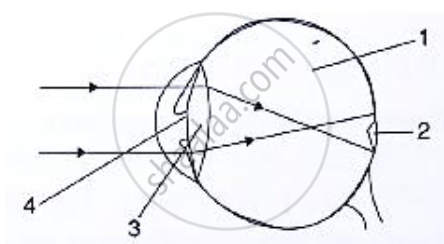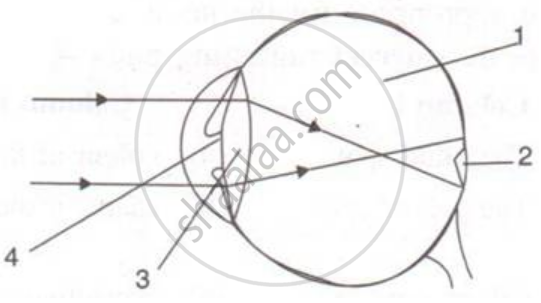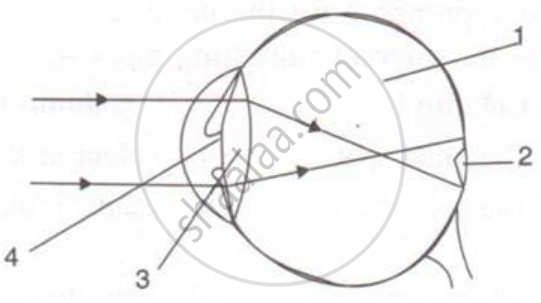Advertisements
Advertisements
Question
Explain two possible reasons of myopia. How can it be corrected? Explain with a suitable diagram.
Solution
Possible reasons of myopia:-
(i) Ciliary muscles do not relax sufficiently. Therefore, the converging power of the eye lens becomes high.
(ii) The distance between the eye lens and the retina increases (relative to the normal eye) as the eyeball is lengthened (elongated) or the eye lens is curved.
Correcting myopia:-
(i) Myopia is corrected using a suitable concave lens. Light rays are diverged by the concave lens before they strike the eye lens.
(ii) A concave lens of appropriate power is chosen to produce the required divergence. Hence, after the converging action of the eye lens, the image is formed on the retina.

APPEARS IN
RELATED QUESTIONS
In a Std. X class out of 40 students 10 students use spectacles, 2 students have positive power and 8 students have negative power of lenses in their spectacles.
Answer the following questions:
(1) What does the negative power indicate?
(2) What does the positive power indicate?
(3) Generally which type of spectacles do most of the students use?
(4) What defect of eyesight do most of the students suffer from?
(5) Give two possible reasons for the above defect.
List three common refractive defects of vision. Suggest the way of correcting these defects.
The kind of lens required to correct Myopia
A student is unable to see clearly the words written on the black board placed at a distance of approximately 3 m from him. Name the defect of vision the boy is suffering from. State the possible causes of this defect and explain the method of correcting it.
Which defect of vision can be rectified:
by using a concave lens?
What is the other name for
hypermetropia
Name the defect of vision which makes the eye-lens cloudy resulting in blurred vision.
Name any two defects of vision which can be corrected by using spectacles.
Your friend can read a book perfectly well but cannot read the writing on blackboard unless she sits on the front row in class.
Is she short-sighted or long-sighted?
Your friend can read a book perfectly well but cannot read the writing on blackboard unless she sits on the front row in class.
What type of lenses-converging or diverging-would an optician prescribe for her?
A person suffering from the eye-defect myopia (short-sightedness) can see clearly only up to a distance of 2 metres. What is the nature and power of lens required to rectify this defect?
The defect of vision which cannot be corrected by using spectacles is:
(a) myopia
(b) presbyopia
(c) cataract
(d) hypermetropia
Though a woman can see the distant object clearly, she cannot see the nearby objects clearly. She is suffering from the defect of vision called:
(a) long-sight
(b) short-sight
(c) hind-sight
(d) mid-sight
A young man has to hold a book at arm's length to be able to read it clearly. The defect of vision is:
(a) astigmatism
(b) myopia
(c) presbyopia
(d) hypermetropia
The defect of vision in which the eye-lens of a person gets progressively cloudy resulting in blurred vision is called:
(a) myopia
(b) presbyopia
(c) colourblindness
(d) cataract
A short-sighted person has a near point of 15 cm and a far point of 40 cm.
(a) Can he see clearly an object at a distance of:
(i) 5 cm?
(ii) 25 cm?
(iii) 50 cm?
(b) To see clearly an object at infinity, what kind of spectacle lenses does he need?
Name the following:
The photosensitive pigment present in the rods of the retina.
Name an old age eye defect. What happens in it?
Describe the mechanism of focusing the image of a distant object in your eye when you raise your head after reading a book.
Explain the terms ‘adaptation’ and ‘accommodation’ with reference to the eye.
Enumerate the common defects of vision, their causes and the possible methods of correcting them.
Given below is a diagram depicting a defect of the human eye. Study the same and answer the question that follow:

Name the defect shown in the diagram.
What eye defect is hypermetropia? Describe with a ray diagram how this defect of vision can be corrected by using an appropriate lens.
What is Hypermetropia (far sightedness)?
State the main functions of the following:
Tears
Choose the correct answer :
Presbyopia is a disease of _____________
Given below is a diagram depicting a defect of the human eye? Study the same and answer the question that follow:

Give two possible reasons for this defect of the eye in human beings.
Given below is a diagram depicting a defect of the human eye? Study the same and answer the question that follow :

Name the type of lens used to correct this eye defect.
Rewrite the following table so as to match second and third column with first column.
|
Column I
|
Column II
|
Column III
|
|
(i) Myopia
|
Old age problem
|
Bifocal lens
|
|
(ii) Presbyopia
|
Nearsightedness
|
Concave lens.
|
A person is unable to see objects distinctly placed within 50 cm from his eyes.
(a) Name the defect of vision the person is suffering from and list its two possible causes.
(b) Draw a ray diagram to show the defect in the above case.
(c) Mention the type of lens used by him for the correction of the defect and calculate its power. Assume that the near point for the normal eye is 25 cm.
(d) Draw a labeled diagram for the correction of the defect in the above case.
Give Reason:
Why do we see clearly in the central region of the retina?
Give Reason:
Older people require glasses to read and write.
Give Reason:
When you enter into a dark room from bright because of sunlight, you can not see things for a few seconds.
Explain the Term: Presbyopia
Give Technical Term:
The path which responsible for protecting the eye from sweat.
Choose the Odd One Out:
In Myopia the human eye _______.
Nearsightedness: elongated eyeball : : farsightedness: _______
Assertion: Concave mirrors are used as reflectors in torches, vehicle head lights and in search lights.
Reason: When an object is placed beyond the center of curvature of a concave mirror, the image formed is real and inverted.
